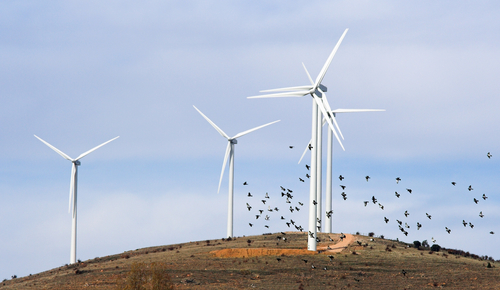
The American Wind Energy Association AWEA) says the domestic wind energy industry “worked diligently to accelerate shovel-ready projects” in 2009 and installed 10 GW, “continued lack of long-term market signals, combined with low power demand and price, has allowed the pipeline for advanced projects to slow over the past 18 months.”
Total installed wind energy capacity in the US now is 35.6 GW. In addition to the 539 installed in Q1, there is 3.3 GW of capacity currently under construction, compared to 4 GW at the start of last year.
AWEA pushes for Renewable Electricity Standard
AWEA wants Congress to implement a strong national renewable electricity standard (RES) as part of comprehensive climate and energy legislation to provide the hard targets needed to stabilize the wind industry.
“Financing wind projects is an 18-month process and the struggles in 2009 to raise new capital, combined with lack of new demand from utilities, are now surfacing in the market and reflected in project installations,” explains Denise Bode of AWEA.
“Minimal new installations and current announcements for project delays or downgrades in 2010 are the consequences of inaction to provide a serious market signal.
“With swift action today, wind project development can be nimble and ramp up quickly, creating new domestic manufacturing orders,” she adds.
Poll shows support for renewable energy
A national RES would send the long-term signal which the wind industry needs to invest and grow in a steady, sustained fashion, and to attract wind turbine manufacturing investment on a large scale, the group explains.
A recent poll conducted for AWEA concluded that a RES is politically popular among US voters, with support across party lines (65% of Republican voters, 69% of Independents and 92% of Democrats) favoring the legislation.
“Wind works for America; that is why voters want Congress to pass a strong national RES,” says Bode. “Americans understand that an RES will mean new manufacturing jobs, less dependence on imported energy, and more pure clean affordable energy for our country.”
“Wind energy is readily available today to revitalize our economy and yet Congress, by not acting, is allowing this bright spot in our economy to dim,” she says. “The American people agree that Congress must act.”
Environment bad for wind energy
The cycle of wind capacity installations over recent years has created a poor environment for long-term investment decisions, particularly in wind manufacturing, AWEA notes.
Dozens of manufacturing companies have already made commitments to build and upgrade US wind facilities, despite the market’s booms and busts, and these companies have created the foundation for renewing the manufacturing sector and the US could see explosive growth the instant there is a sign of market stability and US commitment to long term policy.
Of the 539 MW of new wind capacity, Texas led with 101 MW. The top three states are still Texas, Iowa and California, while Oregon moved into fourth place, just ahead of Washington.
“Policy drives young energy industries as well as established ones, and depending on the policies put in place now we could be hiring or firing by the end of the year and in the years to come,” says Bode.
“Stimulus funding successfully saved thousands of megawatts of shovel ready wind projects and over 40,000 jobs in 2009, but we are setting up a vacuum if we don’t drive stable demand with a national renewable electricity standard.”
